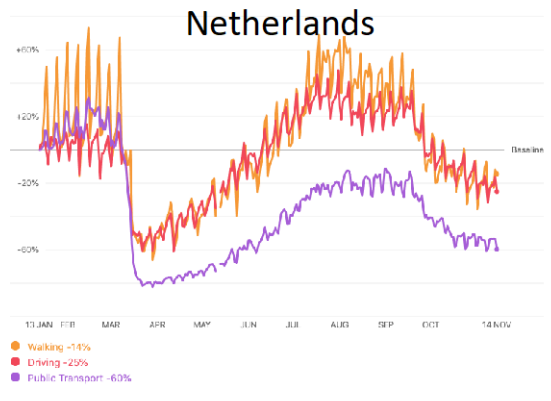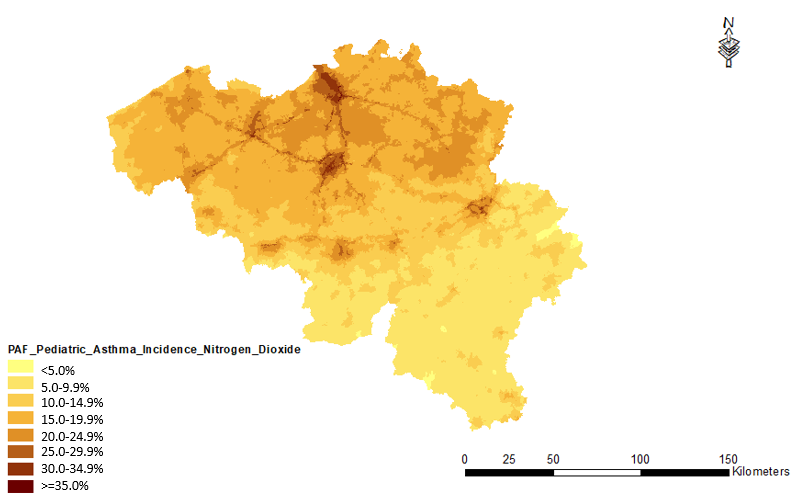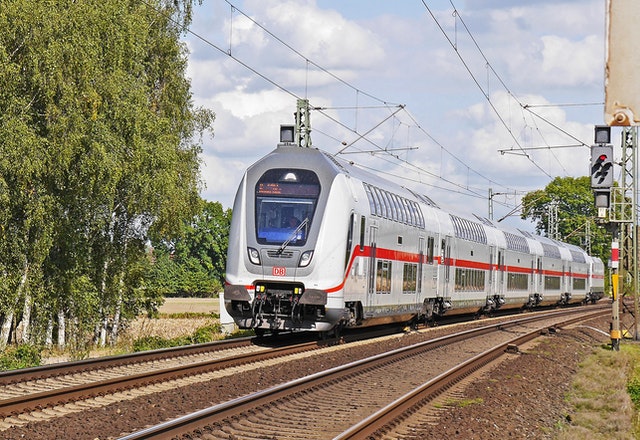Several surveys and studies show an upward trend in car use and a decrease in the use of public transport post-COVID. This is a worrisome evolution that could increase disease, hospitalisations and death. Motorised road transport, in particular cars and trucks, is among the most considerable (avoidable) environmental health burden in Belgium and Europe. Driving a car makes other people sick. More people driving a car implies more asthma, more heart attacks, more cancer, and more brain damage.
Worrisome evolution
Multiple surveys and analyses [1-5] hint at an increased car use and decreased public transport use post-pandemic. Both in terms of our health and in terms of environment and climate, this is a worrisome evolution.
Health perspective
There are several adverse outcomes for health when car use increases (assuming that the current proportion of electric, petrol and diesel vehicles remains the same) while resulting in less utilisation of public transport or multimodal transport. One negative outcome is increased incidence of disease, hospitalisation and death from air pollution. Road traffic is the dominant source of nitrogen dioxide, black carbon and ultrafine particles and is also responsible for a significant fraction of PM2.5 exposure. Therefore, we should expect increases in asthma, cancer incidence, brain damage, myocardial infarctions, diabetes and other health conditions. Other negative outcomes include an increase in traffic fatalities, increased obesity rates in the population and more road noise. While multimodal transport requires more physical activity on average, a greater number of cars on the roads makes cycling and walking less safe and mobility policies focused on car-domination are associated with higher obesity rates in the population. Increased road noise has been found to trigger ischaemic heart disease.
Environmental and climate perspective
From an environmental and climate perspective, greenhouse gas emissions would sharply rise. Road traffic is responsible for 1/5th of greenhouse gas emissions in Europe. In comparison, rail transport is responsible for 0.1% of total greenhouse gas emissions in Europe [6,7].
Economic perspective
From an economic perspective, congestion would worsen, causing economic losses and reduced economic growth [8].

Figure 1: Mobility data from the Netherlands show a weaker revival of public-transport use compared to car-use when measures are relaxed. Car-use even exceeds pre-pandemic levels during periods of relaxed restrictions (e.g. summer 2020). This pattern is observed in multiple countries and regions [9].
The trends of decreased use of multimodal and public transport and increased car use that may occur post-pandemic as the surveys and studies mentioned above tend to point on, could offset more than a decade's progress in improving air pollutant concentrations and convert a stable trend in greenhouse gas emissions to an increase. An accelerated transition to electric cars could offset parts of those negative effects such as exhaust pollution of PM2.5 and NO2, however electric cars remain a cause of non-exhaust emissions of PM, low physical activity, reduced availability of green and recreational spaces, increased greenhouse gas emissions per person compared to public (electric) rail transport and increased congestion and economic losses.
In the surveys mentioned above, avoiding infection with SARS-CoV-2 is often indicated as an important cause of switching from multimodal or public transport to car-oriented transport. The cynical part of this equation is that there is a very low public awareness that such a trend would structurally increase disease, hospitalisations and death for the reasons mentioned above. Driving a car makes other people sick through the several mechanisms discussed above. In addition, increased air pollution as a consequence from increased car-use would 1) increase the likelihood of contracting respiratory infections - such as COVID-19 and influenza - when exposed to those pathogens in areas with elevated PM2.5 levels [10,11], and 2) making the disease more severe in people exposed to elevated long-term air pollutant concentrations,especially nitrogen dioxide (NO2), resulting in higher hospitalisation and mortality rates [11,12]. In addition, for respiratory infections, there can be differences between the actual and perceived risk for infection. Rail transport has in most cases mechanical ventilation systems in places, while cars are badly ventilated (higher percentage of the exhaled air rebreathed by passengers). A report from the GEMS expert group in Belgium finds employees working in passenger rail transport (train conductors, train drivers) do not have any increased risk for catching COVID-19 compared to the general population, while taxi drivers and employees in the airplane sector do have a considerably elevated risk [13].
Relevance for the ELLIS project
In the ELLIS project, one of the objectives is to quantify the burden of disease associated with motorised road traffic and evaluate the potential health benefits of policy interventions on this burden of disease. Despite low public awareness, motorised road transport is one of the most considerable health burdens in Belgium, causing several thousands of deaths per year through various mechanisms. Further in the project, we will detailly quantify this burden of disease for a number of diseases and total mortality.
In the example below, we calculated the Population Attributable Fraction of Asthma to nitrogen dioxide pollution, based on the mean value of reported relative risks in existing meta-reviews, followed by the use of epidemiological formulas to calculate the Population Attributable Fraction based on those mean relative risks reported in existing meta-reviews [14]. The outcome on the map demonstrates the percentage of pediatric asthma incidence that can be attributed to nitrogen dioxide pollution. Formulated in another manner, the percentage of pediatric asthma incidence that would not have occurred if there was no nitrogen dioxide pollution at all. In large cities, where >70% of Nitrogen Dioxide exposure originates from motorised road traffic, it is estimated that 20-35% of pediatric asthma cases is attributable to nitrogen dioxide pollution, and up to >35% in busy trafficked areas (Figure 2).

Figure 2: Proportion of pediatric asthma cases attributable to nitrogen dioxide (NO2) pollution at the statistical sector level in Belgium.
References
- https://www.ipsos.com/sites/default/files/ct/news/documents/2020-03/impact-of-coronavirus-to-new-car-purchase-in-china-ipsos.pdf
- https://its.ucdavis.edu/blog-post/impacts-of-the-covid-19-pandemic-on-transportation-use-updates-from-uc-davis-behavioral-study/
- https://www.fleeteurope.com/fr/remarketing/europe/features/73-expect-use-car-more-after-pandemic-survey?a=FJA05&t%5B0%5D=CarNext&t%5B1%5D=online%20sales&curl=1
- https://www.abc.net.au/news/2021-01-20/melbourne-headed-for-increased-congestion-after-coronavirus/13070236
- https://www.transurban.com/content/dam/transurban-pdfs/03/Mobility-Trends-Report-1H21.pdf
- https://www.eea.europa.eu/data-and-maps/indicators/transport-emissions-of-greenhouse-gases-7/assessment
- https://eudebates.tv/debates/eu-policies/transport-and-travel/the-journey-begins-2021-is-the-european-year-of-rail-euyearofrail/
- https://www.mobilenews.hsbc.com/ar/cutting-congestion-lifts-growth/
- https://www.europarl.europa.eu/RegData/etudes/STUD/2021/658216/IPOL_STU(2021)658216_EN.pdf
- https://documents1.worldbank.org/curated/en/462481587756439003/pdf/Incidence-of-COVID-19-and-Connections-with-Air-Pollution-Exposure-Evidence-from-the-Netherlands.pdf
- Travaglio, M., Yu, Y., Popovic, R., Selley, L., Leal, N. S., & Martins, L. M. (2021). Links between air pollution and COVID-19 in England. Environmental pollution (Barking, Essex : 1987), 268(Pt A), 115859. https://doi.org/10.1016/j.envpol.2020.115859
- Liang, D., Shi, L., Zhao, J., Liu, P., Sarnat, J. A., Gao, S., Schwartz, J., Liu, Y., Ebelt, S. T., Scovronick, N., & Chang, H. H. (2020). Urban air pollution may enhance COVID-19 case-fatality and mortality rates in the United States. Innovation (New York, N.Y.), 1(3), 100047. https://doi.org/10.1016/j.xinn.2020.100047
- https://d34j62pglfm3rr.cloudfront.net/downloads/GEMS_025_Recommendations+NPIs+OCC+20_08_21+.pdf
- Achakulwisut, P., Brauer, M., Hystad, P., & Anenberg, S. C. (2019). Global, national, and urban burdens of paediatric asthma incidence attributable to ambient NO2 pollution: estimates from global datasets. The Lancet. Planetary health, 3(4), e166–e178. https://doi.org/10.1016/S2542-5196(19)30046-4



